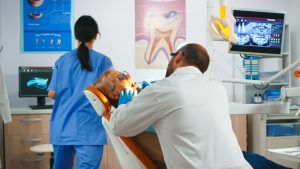 Introduction
Introduction
In today's digital era, information technology (IT) plays a crucial role in the success of businesses across all industries. Dental companies, like any other organizations, heavily rely on IT systems to streamline their operations, manage patient records, and enhance overall efficiency. However, when dental companies adopt the break and fix model in IT support, it can have significant consequences on their operations, productivity, and ultimately, their ability to deliver quality care to patients. In this blog post, we will explore the impact of the break and fix model on dental companies and shed light on the drawbacks of this approach.
Understanding the Break and Fix Model
The break and fix model refers to a reactive approach to IT support. Instead of implementing proactive measures to prevent IT issues, organizations employing this model only address problems as they occur. When a dental company adopts the break and fix model, they typically rely on an IT support provider to respond and resolve issues when they arise, often on a per-incident basis.
Challenges Faced by Dental Companies
- Downtime and Loss of Productivity: The break and fix model is inherently reactive, meaning that issues are only addressed after they have occurred. As a result, dental companies may experience significant downtime during system failures or other IT-related problems. This downtime can disrupt daily operations, leading to reduced productivity and financial losses.
- Higher IT Costs: With the break and fix model, dental companies face unpredictable and unplanned expenses for every IT incident. Instead of having a fixed budget for IT support, they end up paying for each individual problem as it arises. This can lead to inflated IT costs over time, making it challenging for dental practices to allocate funds efficiently and plan for long-term IT investments.
- Inconsistent Service Quality: Relying solely on a break and fix approach means that dental companies are dependent on external IT support providers to fix issues when they occur. This reliance can result in inconsistent service quality, as different technicians may have varying levels of expertise and response times. Inconsistency in IT support can negatively impact the reliability and efficiency of dental practices.
- Data Security Risks: Dental companies deal with sensitive patient information, including medical histories, insurance details, and financial records. The break and fix model may overlook crucial security measures and vulnerability assessments, leaving systems exposed to potential cyber threats. Failure to address these risks promptly can result in data breaches, leading to legal and reputational consequences for the dental practice.
- Missed Opportunities for Innovation: By adopting a reactive approach to IT support, dental companies may miss out on opportunities for innovation and improvement. Proactive IT strategies, such as regular system maintenance, software updates, and technology upgrades, can help dental practices stay ahead of the curve and leverage the latest advancements in the field. Neglecting these opportunities due to the break and fix model can hinder growth and competitiveness in the dental industry.
Benefits of a Proactive IT Support Approach
To overcome the challenges associated with the break and fix model, dental companies can benefit from transitioning to a proactive IT support approach. Some key advantages of proactive IT support include:
- Minimized Downtime: By implementing proactive monitoring and maintenance, potential IT issues can be identified and resolved before they cause significant disruptions. This leads to decreased downtime, improved productivity, and enhanced patient care.
- Cost Savings: Proactive IT support typically operates on a fixed monthly or annual fee structure, allowing dental companies to budget and forecast their IT costs accurately. Preventive measures help minimize the occurrence of major issues, saving money that would otherwise be spent on emergency repairs or data recovery.
- Enhanced Security: Proactive IT support prioritizes robust security measures, including regular system patching, software updates, and firewall management
- This reduces the risk of data breaches, protects patient information, and ensures compliance with privacy regulations.
- Scalability and Future-Proofing: Proactive IT support focuses on aligning IT infrastructure with business goals, allowing dental companies to scale and adapt to changing needs. Regular technology assessments and upgrades ensure that the dental practice remains competitive and able to leverage the latest innovations in the industry.
Conclusion
The break and fix model in IT support can have several detrimental effects on dental companies, including increased downtime, higher costs, inconsistent service quality, security risks, and missed opportunities for innovation. To address these challenges, dental practices should consider transitioning to a proactive IT support approach. By implementing proactive monitoring, regular maintenance, and robust security measures, dental companies can minimize downtime, enhance productivity, improve security, and stay ahead in a rapidly evolving industry. Investing in proactive IT support is an essential step towards ensuring the smooth and efficient functioning of dental practices in today's technology-driven world.
